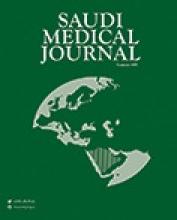Abstract
OBJECTIVE: To determine the prevalence of gastroesophageal reflux disease (GERD) for the management of patients with laryngeal and voice disorders.
METHODS: This study consisted of 30 patients from Ear, Nose and Throat (ENT) and Phoniatric outpatient clinics at Al-Noor Specialist Hospital in Holy Makkah, Saudi Arabia complaining of laryngeal symptoms mainly dysphonia, during one year period from May 2005 to May 2006. All patients were subjected to: voice evaluation, which include searching for etiological factors, auditory perceptual assessment (APA), laryngeal examination and upper gastrointestinal tract (GIT) endoscopy.
RESULTS: The onset of complaint of voice changes was gradual (93%), the duration was more than 6 months (90%) and the course was intermittent in 43% of patients. Phonasthenia symptoms were common. The change of voice was mainly due to high vocal demand (63.3%), tense temperament (93.3%) and spicy foods (60%). The grade of dysphonia was slight in 50% of patients, the characters of voice were mainly strained and leaky (76.7%) and the pitch was mainly decreasing (56.7%). Hyperfunctional dysphonia was present in 26.7% of patients, phonasthenia in 16.7%, vocal fold (VF) polyp in 13.3% and contact granuloma in 6.7%. Presence of GERD with hiatus hernia in 63.3% of patients, GERD with acute gastritis and duodenitis in 10% and incompetent lower esophagus in 6.67%.
CONCLUSION: Laryngeal and voice disorders was mostly due to GERD in 80% of patients, which was mainly GERD with hiatus hernia.
- Copyright: © Saudi Medical Journal
This is an open-access article distributed under the terms of the Creative Commons Attribution-Noncommercial-Share Alike 3.0 Unported, which permits unrestricted use, distribution, and reproduction in any medium, provided the original work is properly cited.






